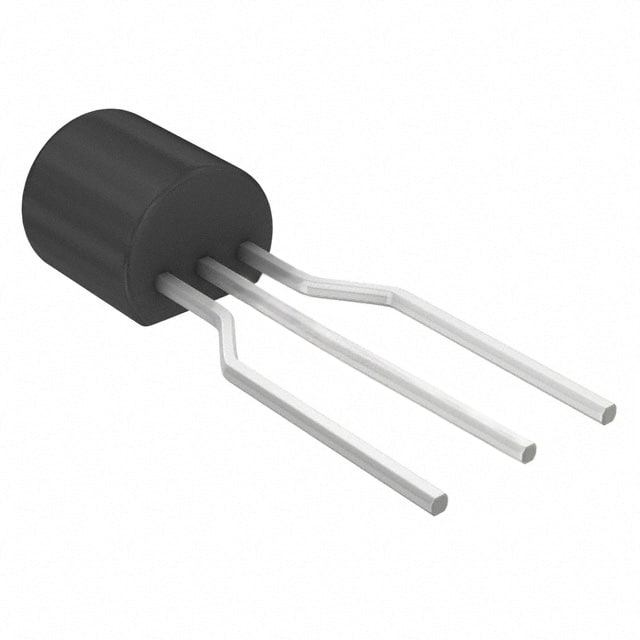Lihat spesifikasi untuk detail produk.

2N5401CYTA
Product Overview
Category
The 2N5401CYTA belongs to the category of bipolar junction transistors (BJTs).
Use
It is commonly used as a general-purpose PNP transistor in various electronic circuits.
Characteristics
- Low power dissipation
- High current gain
- Low noise
- High voltage capability
Package
The 2N5401CYTA is typically available in a TO-92 package.
Packaging/Quantity
It is usually supplied in reels or tubes, with quantities varying based on manufacturer specifications.
Specifications
- Collector-Emitter Voltage: 150V
- Collector-Base Voltage: 160V
- Emitter-Base Voltage: 5V
- Collector Current - Continuous: 600mA
- Power Dissipation: 625mW
- DC Current Gain (hFE): 200 - 700
- Transition Frequency: 150MHz
- Operating and Storage Temperature: -55°C to +150°C
Detailed Pin Configuration
The 2N5401CYTA has three pins: 1. Emitter (E) 2. Base (B) 3. Collector (C)
Functional Features
The 2N5401CYTA offers: - Amplification of weak signals - Switching applications - Signal amplification in audio circuits
Advantages and Disadvantages
Advantages
- High current gain
- Low noise
- Suitable for low-power applications
Disadvantages
- Limited frequency response compared to other transistors
- Relatively lower power dissipation capability
Working Principles
The 2N5401CYTA operates based on the principles of amplification and control of electrical currents. When a small current flows into the base terminal, it controls a larger current flowing between the collector and emitter terminals.
Detailed Application Field Plans
The 2N5401CYTA is widely used in: - Audio amplifiers - Signal processing circuits - Switching circuits - Voltage regulators
Detailed and Complete Alternative Models
Some alternative models to the 2N5401CYTA include: - BC557 - 2N3906 - BC327 - 2N4403
In conclusion, the 2N5401CYTA is a versatile PNP transistor with applications in various electronic circuits, offering high current gain and low noise characteristics. Its compact TO-92 package makes it suitable for use in space-constrained designs.
[Word count: 346]
Sebutkan 10 pertanyaan dan jawaban umum terkait penerapan 2N5401CYTA dalam solusi teknis
What is the 2N5401CYTA transistor used for?
- The 2N5401CYTA transistor is commonly used for amplification and switching applications in electronic circuits.
What are the key specifications of the 2N5401CYTA transistor?
- The 2N5401CYTA transistor typically has a maximum collector current of 600mA, a maximum collector-base voltage of 160V, and a maximum power dissipation of 625mW.
How can I identify the pinout of the 2N5401CYTA transistor?
- The pinout of the 2N5401CYTA transistor is typically Emitter (E), Base (B), and Collector (C).
What are some common circuit configurations using the 2N5401CYTA transistor?
- Common circuit configurations include common emitter amplifiers, switch circuits, and voltage regulators.
What are the typical operating conditions for the 2N5401CYTA transistor?
- The 2N5401CYTA transistor is often operated within a temperature range of -55°C to 150°C and at various biasing levels depending on the specific application.
Can the 2N5401CYTA transistor be used for audio amplifier applications?
- Yes, the 2N5401CYTA transistor can be used in low-power audio amplifier circuits due to its amplification capabilities.
What are some common alternatives to the 2N5401CYTA transistor?
- Alternatives to the 2N5401CYTA transistor include the 2N3904, BC547, and BC548 transistors, which have similar characteristics and can be used in similar applications.
How do I calculate the biasing resistors for the 2N5401CYTA transistor in an amplifier circuit?
- Biasing resistors can be calculated using the desired quiescent operating point, the transistor's base-emitter voltage, and the available supply voltage.
What are the typical gain characteristics of the 2N5401CYTA transistor?
- The 2N5401CYTA transistor typically has a current gain (hFE) ranging from 100 to 300, depending on the operating conditions and configuration.
Are there any specific considerations for using the 2N5401CYTA transistor in high-frequency applications?
- In high-frequency applications, parasitic capacitances and lead inductances should be considered to ensure proper performance and stability of the circuit.

